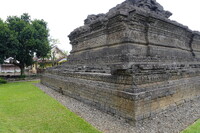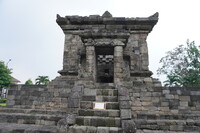 Jago Temple
Jago Temple Candi Jago, located in Tumpang, Malang, East Java, Indonesia, is a 13th-century Hindu-Buddhist temple built during the Singhasari Kingdom. It is believed to have been constructed as a memorial for King Wisnuwardhana, a ruler of Singhasari, around 1268–1280 CE. The name "Jago" is thought to derive from the ancient Javanese word "Jajaghu," which means "glorious," reflecting its significance as a spiritual and cultural landmark. The temple's architecture and carvings illustrate the syncretism of Hindu and Buddhist influences that characterized the religious practices of the time.Physically, Candi Jago is notable for its unique stepped-pyramid design, a departure from the more vertical structures of earlier temples. The base of the temple is square, measuring approximately 23 meters on each side, with a terraced design leading to a now-missing main chamber and roof. Its walls are adorned with intricate bas-reliefs depicting scenes from Hindu epics such as the Mahabharata and Ramayana, as well as Buddhist narratives like the Jataka tales. These carvings not only highlight the temple's artistic mastery but also provide a glimpse into the moral and spiritual values of the Singhasari period.
Despite its historical significance, much of Candi Jago is in a state of ruin due to centuries of weathering and human intervention. The roof and upper structures have been lost, and some carvings have deteriorated. Nevertheless, restoration efforts have helped preserve the remaining elements, ensuring that visitors can still appreciate its beauty and historical importance. Today, Candi Jago serves as a vital link to Indonesia’s rich cultural heritage, attracting tourists, researchers, and spiritual seekers alike.
 Badut Temple
Badut Temple Candi Badut, located in Malang, East Java, Indonesia, is a small yet historically significant Hindu temple believed to have been built in the 8th century during the era of the Kanjuruhan Kingdom. As one of the oldest temples in East Java, it holds great importance in understanding the early spread of Hindu culture and architecture in the region. The temple’s structure is relatively simple, with a square base and a central chamber (cella) that once housed a Lingga-Yoni, symbolizing the worship of Shiva, a key deity in Hinduism. Although parts of the temple have been damaged or eroded over time, the remaining carvings and architectural elements reflect the early Javanese style of stone construction, characterized by minimalistic yet meaningful designs.The temple’s name, “Badut,” which translates to “clown” in modern Indonesian, is intriguing, though its connection to the temple's purpose or history is unclear. Located in the Tidar area, on the western outskirts of Malang, Candi Badut is surrounded by lush greenery, providing a tranquil environment that enhances its spiritual and historical atmosphere. Efforts have been made to restore and preserve the site, making it a popular destination for both tourists and researchers. Its accessibility and cultural significance make Candi Badut not only a treasure of Malang’s heritage but also an important link to the early history of Hinduism in Java.
 Jago Temple Candi Jago, located in Tumpang, Malang, East Java, Indonesia, is a 13th-century Hindu-Buddhist temple built during the Singhasari Kingdom. It is believed to have been constructed as a memorial for King Wisnuwardhana, a ruler of Singhasari, around 1268–1280 CE. The name "Jago" is thought to derive from the ancient Javanese word "Jajaghu," which means "glorious," reflecting its significance as a spiritual and cultural landmark. The temple's architecture and carvings illustrate the syncretism of Hindu and Buddhist influences that characterized the religious practices of the time.Physically, Candi Jago is notable for its unique stepped-pyramid design, a departure from the more vertical structures of earlier temples. The base of the temple is square, measuring approximately 23 meters on each side, with a terraced design leading to a now-missing main chamber and roof. Its walls are adorned with intricate bas-reliefs depicting scenes from Hindu epics such as the Mahabharata and Ramayana, as well as Buddhist narratives like the Jataka tales. These carvings not only highlight the temple's artistic mastery but also provide a glimpse into the moral and spiritual values of the Singhasari period. Despite its historical significance, much of Candi Jago is in a state of ruin due to centuries of weathering and human intervention. The roof and upper structures have been lost, and some carvings have deteriorated. Nevertheless, restoration efforts have helped preserve the remaining elements, ensuring that visitors can still appreciate its beauty and historical importance. Today, Candi Jago serves as a vital link to Indonesia’s rich cultural heritage, attracting tourists, researchers, and spiritual seekers alike.
Jago Temple Candi Jago, located in Tumpang, Malang, East Java, Indonesia, is a 13th-century Hindu-Buddhist temple built during the Singhasari Kingdom. It is believed to have been constructed as a memorial for King Wisnuwardhana, a ruler of Singhasari, around 1268–1280 CE. The name "Jago" is thought to derive from the ancient Javanese word "Jajaghu," which means "glorious," reflecting its significance as a spiritual and cultural landmark. The temple's architecture and carvings illustrate the syncretism of Hindu and Buddhist influences that characterized the religious practices of the time.Physically, Candi Jago is notable for its unique stepped-pyramid design, a departure from the more vertical structures of earlier temples. The base of the temple is square, measuring approximately 23 meters on each side, with a terraced design leading to a now-missing main chamber and roof. Its walls are adorned with intricate bas-reliefs depicting scenes from Hindu epics such as the Mahabharata and Ramayana, as well as Buddhist narratives like the Jataka tales. These carvings not only highlight the temple's artistic mastery but also provide a glimpse into the moral and spiritual values of the Singhasari period. Despite its historical significance, much of Candi Jago is in a state of ruin due to centuries of weathering and human intervention. The roof and upper structures have been lost, and some carvings have deteriorated. Nevertheless, restoration efforts have helped preserve the remaining elements, ensuring that visitors can still appreciate its beauty and historical importance. Today, Candi Jago serves as a vital link to Indonesia’s rich cultural heritage, attracting tourists, researchers, and spiritual seekers alike. Badut Temple Candi Badut, located in Malang, East Java, Indonesia, is a small yet historically significant Hindu temple believed to have been built in the 8th century during the era of the Kanjuruhan Kingdom. As one of the oldest temples in East Java, it holds great importance in understanding the early spread of Hindu culture and architecture in the region. The temple’s structure is relatively simple, with a square base and a central chamber (cella) that once housed a Lingga-Yoni, symbolizing the worship of Shiva, a key deity in Hinduism. Although parts of the temple have been damaged or eroded over time, the remaining carvings and architectural elements reflect the early Javanese style of stone construction, characterized by minimalistic yet meaningful designs.The temple’s name, “Badut,” which translates to “clown” in modern Indonesian, is intriguing, though its connection to the temple's purpose or history is unclear. Located in the Tidar area, on the western outskirts of Malang, Candi Badut is surrounded by lush greenery, providing a tranquil environment that enhances its spiritual and historical atmosphere. Efforts have been made to restore and preserve the site, making it a popular destination for both tourists and researchers. Its accessibility and cultural significance make Candi Badut not only a treasure of Malang’s heritage but also an important link to the early history of Hinduism in Java.
Badut Temple Candi Badut, located in Malang, East Java, Indonesia, is a small yet historically significant Hindu temple believed to have been built in the 8th century during the era of the Kanjuruhan Kingdom. As one of the oldest temples in East Java, it holds great importance in understanding the early spread of Hindu culture and architecture in the region. The temple’s structure is relatively simple, with a square base and a central chamber (cella) that once housed a Lingga-Yoni, symbolizing the worship of Shiva, a key deity in Hinduism. Although parts of the temple have been damaged or eroded over time, the remaining carvings and architectural elements reflect the early Javanese style of stone construction, characterized by minimalistic yet meaningful designs.The temple’s name, “Badut,” which translates to “clown” in modern Indonesian, is intriguing, though its connection to the temple's purpose or history is unclear. Located in the Tidar area, on the western outskirts of Malang, Candi Badut is surrounded by lush greenery, providing a tranquil environment that enhances its spiritual and historical atmosphere. Efforts have been made to restore and preserve the site, making it a popular destination for both tourists and researchers. Its accessibility and cultural significance make Candi Badut not only a treasure of Malang’s heritage but also an important link to the early history of Hinduism in Java.